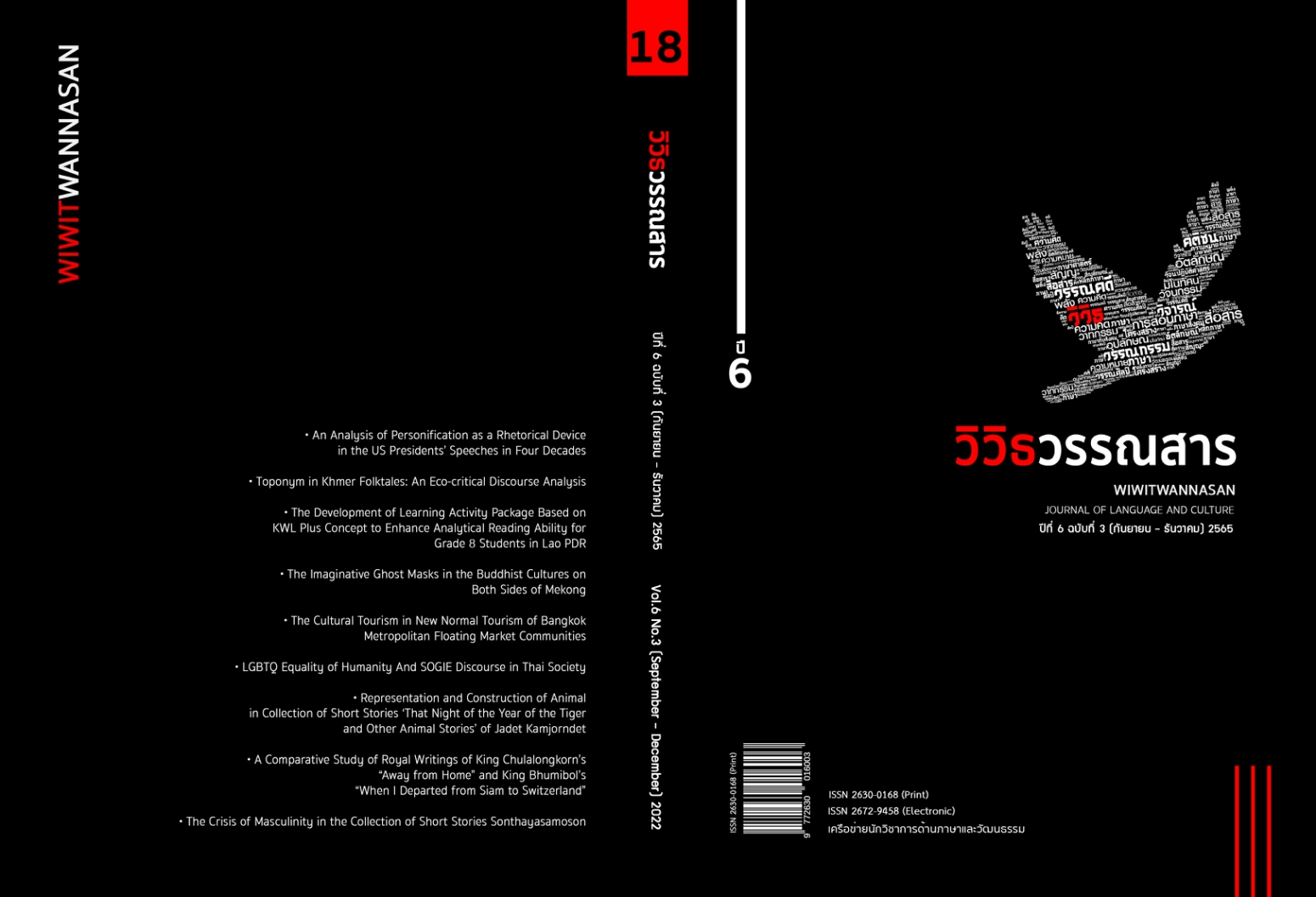จินตนาการหน้ากากผีในวัฒนธรรมพุทธสองฝั่งโขง
Main Article Content
บทคัดย่อ
บทความนี้มุ่งศึกษาการเล่นหน้ากากผีในพิธีกรรมการแห่ผีตาโขนอำเภอด่านซ้าย ผีขนน้ำ ผีโขนปากลาย และผีบุ้งเต้า การศึกษาพบว่า 1) หน้ากากผีในพิธีกรรมทั้ง 4 แบบเป็นการสร้างสรรค์ผีในให้มีพื้นที่ในพิธีกรรม การสวมหน้ากากถือเป็นส่วนหนึ่งของพิธีกรรม และเกี่ยวข้องกับจินตนาการของคนในสังคมที่เล่นหน้ากากผี 2) การสวมหน้ากากผีทั้ง 4 แบบเป็นการประสานความเป็นผีเข้ากับตัวของคนในชุมชนที่นับถือพุทธศาสนาอันเป็นการทำให้ผีมีความสัมพันธ์กับพุทศาสนา 3) หน้ากากผีทั้ง 4 แบบ มีวัฒนธรรมการสวมหน้ากากผีตาโขนมีที่มาจากการเล่นโขนตอนเชิญพระเวสสันดรกลับเข้าเมืองสีวีราษฎร์ในมหาชาติลาวและอีสานกัณฑ์มหาราช การส่วนหน้ากากผีบุ้งเต้าเป็นการสร้างหน้ากากผีให้บูชาพระพุทธรูป มีเพียงการสวมหน้ากากผีขนน้ำเท่านั้นที่ทำเพื่อแสดงความกตัญญูต่อสัตว์ และ 4) หน้ากากผีที่ปรากฏทั้ง 4 แบบเป็นการเล่นหน้ากากของคนในชุมชนนับถือพุทธศาสนาเป็นใหญ่จึงทำให้ผีเป็นความเชื่อที่อิงอาศัยพุทธศาสนา วัฒนธรรมการสวมหน้ากากในวัฒนธรรมชาวพุทธสองฝั่งโขงคือการสวมทับภาวะผีเข้ามาเป็นส่วนหนึ่งในพิธีกรรมพุทธ และมักนำหน้ากากผีมาใช้ในพิธีแห่ หน้ากากผีที่สวมทับในพิธีแห่ทั้ง 4 แบบสื่อให้เห็นจินตนาการถึงวัฒนธรรมความเชื่อเรื่องผีผ่านหน้ากากที่สร้างขึ้นในพิธีกรรม ที่สืบย้อนให้ทราบถึงการดำรงอยู่ของความเชื่อผีภายใต้วัฒนธรรมพุทธศาสนาเป็นใหญ่ในพื้นที่สองฝั่งโขงแบบถ้อยทีถ้อยอาศัย แง่นี้เองการสวมหน้ากากผีจึงเป็นหลักฐานแสดงให้เห็นถึงการสร้างผีให้สามารถจับต้องได้ผ่านหน้ากาก และให้ดำรงอยู่ในที่แจ้งได้ในวัฒนธรรมของชาวพุทธสองฝั่งโขงได้อย่างลงตัว
Article Details

อนุญาตภายใต้เงื่อนไข Creative Commons Attribution-NonCommercial-NoDerivatives 4.0 International License.
ลิขสิทธิ์ของบทความเป็นของวารสาร การพิมพ์ซ้ำจะต้องได้ร้บการอนุญาตจากบรรณาธิการวารสาร
เอกสารอ้างอิง
Anumamrajathon, P. (1988). Traditions about the birth and death. Bangkok: Teachers Council of Latphrao Printing. (In Thai)
Ariyanuwat, P. (1993). Isan people’s beliefs. In P. Duke et al. (ed). Folk culture: Beliefs. (pp 1-15). Bangkok: Chulalongkorn University Press. (In Thai)
Department of Fine Arts Department. (1990). Sukhothai stone inscription The first stone inscription of King Ramkhamhaeng. Bangkok: Thailand National Library. (In Thai)
Khotkhantha. M. (2022). Isan Tradition. Retrieved from https://www.isangate.com/new/isan tradition.html. (In Thai)
JantaJorn, S. [Tran.]. (2008). Lao history (prehistoric - to the present). Kalasin: Prasan Printing. (In Thai)
Kijwang. B. (2022). Phi Ta Khon Museum at Wat Phonchai Dan Sai District Loei Province. Retrieved from http://www.snc.lib.su.ac.th/snclibblog/?p=38189. (In Thai)
Loei Rajabhat University. (2013). Thai identity and culture of Loei. Loei: Loei Rajabhat University. (In Thai)
Ladkhang Subdistrict Administrative Organization. (2020). Local landmark. Retrieved from http://ladkang.go.th/public/locallandmark/data/detail/locallandmark. (In Thai)
Maliwan, P. (1990). Lam Phra Wet-Sermon Mahachat or Mahaesantra Jataka Isan version. Bangkok: Mahachulalongkornrajavidyalaya University. (In Thai)
Ministry of Education, Fine Arts and Sports and Youth of Lao. (1996). Antecedents of Luang Prabang. Vientiane: Lao National Library. (In Lao)
Ministry of Public Relations and Culture of Lao. (2000). Lao history (primitive - present). Vientiane: Lao Government Printing. (In Lao)
Nimmanahaeminda, P. (2002).Folk tales studies (2nd ed.). Bangkok: Chulalongkorn University Press. (In Thai)
Rattanawong, S. & Bernard, G. [Tran.]. (nd.). Lao in 1640. Vientiane: Lao Government Press. (In Lao)
Sakularakarunothai, T. (2015). The ceremony of Phi Ta Khon festival to contemporary jewelry (Master's thesis). Silpakorn University. (In Thai)
Sang-Akhom (2000). Lao National and Lao people in past and present. Vientiane: Nagornluang Printing. (In Lao)
Sompong, P. (2019). A study the Pi Ta Khon Festival of Laos according to the concept of the structure of mass communication (Bachelor’s thesis). Sudsaka College for Management and Technology of Lao. (In Lao)
Weerajit Mahathera, (1992). Mahachat sermon. np. (In Lao)
Werawong, S. (2001). Ancient Lao history to 1946. Vientiane: Nanthatulad Printing. (In Lao)
Werawong, S. & Uthensakda, N. (1994). The legend of King Khunbarom. Vientiane: Lao National Library. (In Lao)
Winyarat, J. [Tran.]. (2010). Lao history. Bangkok: Social Sciences and Humanities Textbook Project Foundation. (In Thai)


